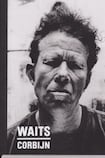
Yes, you read correctly: €148, give or take VAT and special offers. It's limited to 6,600 copies, and what you get for your money is a collector's-edition coffee-table art book in a linen slip case. And what a book, what an artefact: a collection of superb images by Anton Corbijn, the acclaimed music photographer (now making a name as a film director), and a gathering of erratic images by Tom Waits, the idiosyncratic songwriter and performer.
The collaboration started in Amsterdam in 1977, when the Dutch photographer went backstage at a Waits concert and snapped a few rounds with his Kodak Tri-X. The relationship, tenuous though it may have been at that point, resumed in Los Angeles the following year.
Corbijn, who was visiting the US for the first time, took a taxi to his budget accommodation on Santa Monica Boulevard. The Tropicana Motel at this time was to LA what the Chelsea Hotel was to New York: a resting place for the rock’n’roll fraternity, the freaks, the oddballs.
On stepping out of the taxi, adjusting his eyes to the brightness, Corbijn noticed a man sitting on the sidewalk, recognised him as Waits, and walked over to reintroduce himself.
Waits, who lived in a bungalow at the back of the motel, hadn’t recognised the tall, sharply dressed man with the dignified demeanour.
At this point Waits was famous, influenced by, though not creatively manacled to, the beat writers Jack Kerouac and John Fante. He had been recording since the early 1970s – albums such as Closing Time, The Heart of Saturday Night, Nighthawks at the Diner, Small Change and Foreign Affairs, which reflected his distinctive persona and portrayed a microscopically detailed range of American noir characters and places.
“Kerouac,” writes Robert Christgau in his lengthy introduction, “could have written ‘dark warm narcotic American night’ but not ‘don’t defrost the ice box with a ballpoint pen’.”
Waits’s music was a blend of jazz, cocktail lounge and crooner ballads delivered in a voice once described as sounding as if it was “soaked in a vat of bourbon, left hanging in the smokehouse for a few months, and then taken outside and run over with a car”.
Corbijn, on the other hand, was virtually unknown. He had started his career as a photographer in the mid 1970s, in Groningen, and had gained a reasonably high profile in the Netherlands, but found international recognition only late in the decade, when he moved to London, where his work regularly featured in the weekly music paper New Musical Express and the monthly style bible the Face.
Despite the difference in their backgrounds and profiles, the relationship between Waits and Corbijn flourished.
Nearly four decades later, the evidence is here for all to see. Starting with the black-and-white images he took backstage in Amsterdam, Corbijn compiled an archive, taking photos each time the pair met in the intervening period. The images are mostly of Waits and Waits alone; few other people appear, as though Corbijn is emphasising that Waits is interesting enough.
Each image, then, reflects Waits’s comedic, sometimes juvenile, sometimes wise personality. It has been noted before of Corbijn that he photographs quickly, in order to create intimate portraits of famous people who don’t necessarily want to let their guard down.
Yet such is the closeness between photographer and subject that it becomes almost impossible to determine what was natural and what was posed.
The early Amsterdam and Tropicana Motel shots seem the most naive and vulnerable, yet the book comes into its own with the tranche of images taken from the late 1980s onwards: Waits perched on a tree branch, standing in an industrial mud pool, walking on a beach, encumbered by musical instruments, wearing a cape. Images taken within the past 10 years, mostly at or near Waits’s home in California, portray a man totally comfortable with his persona in all its strands.
After 145 photographs of Waits come photographs by Waits. He describes them as curiosities, and they are, to all intents, fragments captured by a questioning mind: out-of-focus self-portraits, images of oil stains, rabbits, trees, graffiti on doors, roadside-cafe menus, crows and a bizarre image comprising, writes Waits, “things I found on the ground”.
Anything more different from Corbijn’s resonant, dramatic images would be hard to find, but that is clearly the nature of the relationship. One man is focused in every sense of the word; the other is a creative maverick magician, with a beatnik world view, who picks holes in the fabric of the US. “If two people know the same things,” Waits once said, “one of you is unnecessary.”
As a document of one of the longest collaborations between two artists, this expensive book is a trove. Or, as the film-maker Jim Jarmusch, Waits's long-time friend, says at the start of this book: "I ain't no academic, but I can tell you this: a collection of images of Tom Waits seen through the eyes of Anton Corbijn is something special, some kind of vortex, an axis of evil geniuses. What an interesting thing to have landed from a slightly darkened and evocative sky."
Tony Clayton-Lea writes on pop culture and the arts for The Irish Times.










